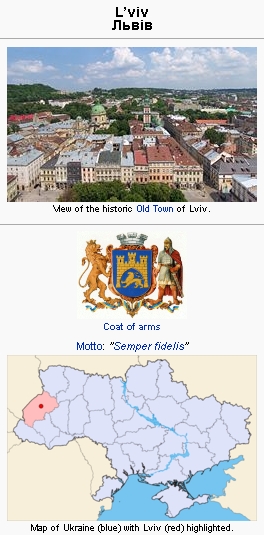Difference between revisions of "Lemberg (Lviv Oblast, Ukraine)"
| [checked revision] | [checked revision] |
GameoAdmin (talk | contribs) (CSV import - 20130823) |
m (Text replace - "Karlsruhe; Schneider, 1913-1967: v. II" to "Karlsruhe: Schneider, 1913-1967: v. II") |
||
| Line 9: | Line 9: | ||
Bachmann, P. <em>Mennoniten in Kleinpolen. </em>Lemberg, 1934. | Bachmann, P. <em>Mennoniten in Kleinpolen. </em>Lemberg, 1934. | ||
| − | Hege, Christian and Christian Neff. <em>Mennonitisches Lexikon</em>, 4 vols. Frankfurt & Weierhof: Hege; Karlsruhe | + | Hege, Christian and Christian Neff. <em>Mennonitisches Lexikon</em>, 4 vols. Frankfurt & Weierhof: Hege; Karlsruhe: Schneider, 1913-1967: v. II, 656 f. |
{{GAMEO_footer|hp=Vol. 3, pp. 319-320|date=1958|a1_last=Bender|a1_first=Harold S|a2_last=|a2_first=}} | {{GAMEO_footer|hp=Vol. 3, pp. 319-320|date=1958|a1_last=Bender|a1_first=Harold S|a2_last=|a2_first=}} | ||
Revision as of 03:04, 20 January 2014

Lemberg (Lviv, Lvov) is a city (1950 population, 330,000; 2001 population, 725,000; coordinates: 49° 51′ 0″ N, 24° 1′ 0″ E) formerly in Poland, now in Ukraine. In the 15th century Lemberg had a strongly German stamp. Decrees were issued in the German language and German was the language of church services. In the next century the awakening nationalistic spirit made Lemberg a bulwark of Polish thought. After the first division of Poland in 1772 Lemberg was ceded to Austria. In spite of the attempt to Germanize it, Lemberg remained Polish, with a strong Ruthenian element.
The Mennonite community in Galicia, which had been established in 1784, was located at first in three villages about three miles southwest of Lemberg, the capital of the province, with Einsiedel as the center and the seat of one of the congregations. In 1830, a subsidiary settlement (Neuhof) was made in a village about 10 miles (16 km) northwest of the villages, which also became a daughter congregation. Further settlements were made on scattered larger estates, of which Kiernica—5 miles (8 km) east of Grodek, 10 miles (16 km) west of Lemberg—became (1860) the seat of a congregation. Gradually the older settlements dissolved and the families scattered, so that by 1914 the 400 baptized members were living in over 100 places. In 1909 the previous congregations were united in one and the name Kiernica-Lemberg given to it, with Lemberg the seat. In 1936 only 57 (souls) Mennonites were living in the city of Lemberg.
In 1911 a one-story building at 23 Koshanovski Street was purchased in which a chapel, a parsonage, a council room, and a janitor's apartment were housed. In 1925 a second floor was built to furnish quarters for students and houseparents, called a Schülerheim
In 1939-40, as a result of an agreement between Germany and Russia, all Germans were evacuated from this region and the Galician Mennonites were resettled in the region of Thorn and Posen. Thus the Lemberg congregation came to an end. Lemberg became Russian.
Bibliography
Bachmann, P. Mennoniten in Kleinpolen. Lemberg, 1934.
Hege, Christian and Christian Neff. Mennonitisches Lexikon, 4 vols. Frankfurt & Weierhof: Hege; Karlsruhe: Schneider, 1913-1967: v. II, 656 f.
| Author(s) | Harold S Bender |
|---|---|
| Date Published | 1958 |
Cite This Article
MLA style
Bender, Harold S. "Lemberg (Lviv Oblast, Ukraine)." Global Anabaptist Mennonite Encyclopedia Online. 1958. Web. 16 Apr 2024. https://gameo.org/index.php?title=Lemberg_(Lviv_Oblast,_Ukraine)&oldid=106891.
APA style
Bender, Harold S. (1958). Lemberg (Lviv Oblast, Ukraine). Global Anabaptist Mennonite Encyclopedia Online. Retrieved 16 April 2024, from https://gameo.org/index.php?title=Lemberg_(Lviv_Oblast,_Ukraine)&oldid=106891.
Adapted by permission of Herald Press, Harrisonburg, Virginia, from Mennonite Encyclopedia, Vol. 3, pp. 319-320. All rights reserved.
©1996-2024 by the Global Anabaptist Mennonite Encyclopedia Online. All rights reserved.
